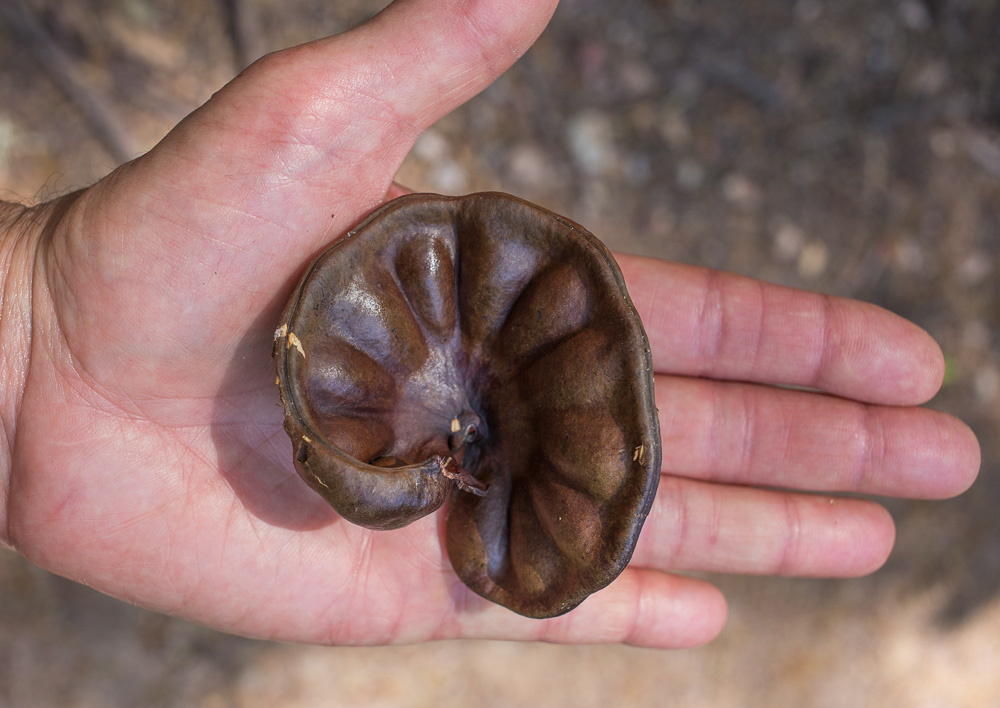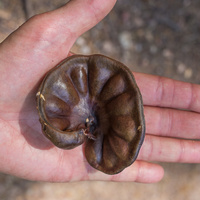Common name: Elephant Ear
Other common names: Devils Ear, Earpod, Monkey Soap, Monkey Earpod
Description
Elephant Ear is a nitrogen-fixing tree legume originating in Central and South America, its natural range extending from Mexico to northern Brazil.
It is a fast-growing tree, adding 1 to 1.5 m (3.3 to 5 ft) in height per year, and in natural forests may reach heights of 30 m (90 ft) or more with a straight and buttressed trunk. On open sites, trees are typically 15 to 20 m (30 to 65 ft) tall, with a stout trunk supporting a wide-branching or umbrella-shaped crown. The bark is corky and light grey or brown.
The leaves are up to 40 cm (1.3 ft) long and twice-feathered, consisting of small oval leaflets closely arranged in pairs along each leaf branch. They are shed in the dry season to conserve water, the branches left bare until the new leaves emerge just before the rainy season.
Flowering occurs soon after the leaves are shed. The flowers are small with white stamens in a round pom-pom shape. Curious seedpods follow that are up to 10 cm (4 in) wide and curved in an ear shape. Green when young, they become dark brown and woody, then detach and fall to the ground.

Darwin, Australia
Use
Elephant Ear is cultivated as an amenity shade tree in its native range and to shade crops such as coffee (Coffea arabica). It does this well because of its wide-spreading crown, fast growth and nitrogen-fixing ability, helping to enrich the soil as it grows.
The wood is light- to medium-weight, in the 320 to 640 kilograms per cubic meter (20 to 40 lbs per cubic ft) range and has variable resistance to decay and wood-boring insects, ranging from resistant to non-resistant.
Variability in wood weight and natural resistance can be explained, at least in part, by differences in tree growth rates, with trees in low rainfall areas tending to grow slower and produce a heavier and more naturally resistant wood than trees in high rainfall areas.
Well-formed logs are sawn into lumber for making furniture, cabinets, gun stocks and packing cases. It is also used for interior trim and panelling and is suitable for boat building because of its durability in water. In roundwood form, it is turned into decorative bowls and other artisan objects. The heartwood is brown with various shadings, sometimes with a reddish tinge and darker shades resembling walnut.
Livestock browse on the fallen seedpods, made palatable by their dry, sugary pulp. They have a crude protein content approaching 20% of their dry weight.
Health use
In Mexico, a sweet syrup is made from the bark and used to treat coughs and colds.
Climate
Grows naturally in sub-humid to moderately humid subtropical and tropical climates, generally frost-free areas with annual lows of 18 to 25°C, annual highs of 27 to 35°C, annual rainfall of 800 to 2800 mm and a dry season of 3 to 8 months.
Growing
New plants are usually started from seed. Elephant Ear trees perform best on moist to dry, free-draining loam, sandy-loam and loamy-sand soils of an acid to slightly alkaline nature, generally with a pH of 5.0 to 7.5, and on sites with full to partial sun exposure. Has good tolerance to drought and nutrient-poor soils and has shown resistance to hurricane-force winds.
Problem features
It is recorded as a weed in at least one reference publication and as naturalised on the island of Puerto Rico. However, there are no records of it anywhere as a serious weed or invasive species. The Hawaii Pacific Weed Risk Assessment project (HPWRA) assessed it as a low weed risk species for Hawaii.
Develops shallow-surfaced, radiating roots that can tilt sidewalks and foundations, making it unsuitable for planting near buildings and other structures. The fallen seedpods create litter, and sawdust from the wood is a known allergen and respiratory irritant.
Where it grows
References
Books
-
Adams, C. D. 1972, Flowering plants of Jamaica, University of the West Indies, Mona, Greater Kingston
-
Allen, O. N. & Allen, E. K. 1981, The Leguminosae : a source book of characteristics, uses, and nodulation, University of Wisconsin Press, Madison, Wisconsin
-
Barwick, M., et al. 2004, Tropical & subtropical trees : a worldwide encyclopaedic guide, Thames and Hudson, London
-
Berni, C. A & Bolza, E. & Christensen, F. J. 1979, South American timbers - the characteristics, properties and uses of 190 species, Commonwealth Scientific and Industrial Research Organization (CSIRO), Division of Building Research, Highett, Victoria, Australia
-
Chudnoff, M. 1984, Tropical timbers of the world, Forest Service, U.S. Department of Agriculture (USDA), Washington, D.C.
-
Francis, J. K. 1998, Tree species for planting in forest, rural, and urban areas of Puerto Rico, U.S. Department of Agriculture, Forest Service, International Institute of Tropical Forestry, Río Piedras, Puerto Rico
-
Francis, J. K. and Liogier, H. A. 1991, Naturalized exotic tree species in Puerto Rico, General technical report SO-82, USDA Forest Service, Southern Forest Experiment Station, New Orleans
-
Francis, J. K. et al. 2000, Silvics of Native and Exotic Trees of Puerto Rico and the Caribbean Islands, Technical Report IITF-15, USDA Forest Service, Rio Piedras, Puerto Rico
-
Gohl, B. 1981, Tropical Feeds : feed information summaries and nutritive values (Revised edition), Food and Agriculture Organization of the United Nations (FAO), Rome
-
Holttum, R. E. & Enoch, I. C. 2010, Gardening in the tropics : the definitive guide for gardeners, Marshall Cavendish Editions, Singapore
-
Howes, F. N. 1949, Vegetable gums and resins, Chronica Botanica Company, Waltham, Massachusetts
-
Kukachka, B. F & Forest Products Laboratory (U.S.) 1970, Properties of imported tropical woods, United States, Department of Agriculture, Forest Service, forest Products Laboratory, Madison
-
Little, E. L. 1974, Trees of Puerto Rico and the Virgin Islands, Vol. 2, United States Department of Agriculture (USDA), Washington D.C.
-
Macmillan, H. F. 1943, Tropical planting and gardening : with special reference to Ceylon, 5th ed, Macmillan Publishing, London
-
Nussinovitch, A. 2010, Plant gum exudates of the world : sources, distribution, properties, and applications, CRC Press / Taylor & Francis, Boca Raton, Florida
-
Porter, T. 2012, Wood : identification & use, Compact edition, Guild of Master Craftsman Publications, Lewes, East Sussex
-
Randall, R. P. 2002, A global compendium of weeds, R.G. and F.J. Richardson Press, Melbourne
-
Randall, R. P. 2007, The introduced flora of Australia and its weed status, Cooperative Research Centre for Australian Weed Management, Glen Osmond, South Australia
-
Record, S. J. & Hess, R. W., 1972, Timbers of the New World, Yale University Press, New Haven, Connecticut & Arno Press, New York
-
Reyes, G. 1992, Wood densities of tropical tree species, U.S. Department of Agriculture, Forest Service, Southern Forest Experiment Station, New Orleans, Louisiana
-
Rose, J. N. 1899. Notes on useful plants of Mexico. Contributions from the United States National Herbarium, Vol. 5.
-
Scheffer, T. C & Morrell, J. J. 1998, Natural durability of wood : a worldwide checklist of species, Forest Research Laboratory, Oregon State University, Corvallis, Oregon
-
Vázquez, Y. C. 1999, Potentially valuable Mexican trees for ecological restoration and reforestation, Institute of Ecology, Database SNIB-REMIB-CONABIO, Project J084, Mexico
-
Vozzo, J. A 2002, Tropical tree seed manual, U.S. Department of Agriculture (USDA), Forest Service, Washington D.C.


